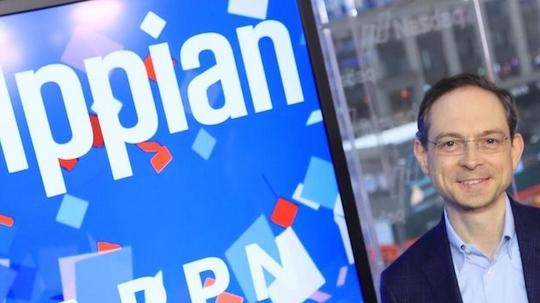
It's been a while since the D.C. region's tech community had the chance to dig through a local company's S-1 filing, or the Securities and Exchange Commissions document filed when a company plans to go public. Now, we have Appian.
The document provides some interesting details on the inner-workings of a company, such as executive compensation, possible risks for the company and even what the company plans to use its IPO earnings for.
Reston, Va.-based Appian will trade under the ticker symbol "APPN," and Morgan Stanley, Goldman Sachs, and Barclays are lead underwriters in the deal. The company plans to offer 6.3 million shares at $12 a piece. The company started back in the dot-com bubble in 1999, and it provides app development software for businesses and government services.
Ahead of Appian's debut on the Nasdaq today, here are some interesting details to know about the company based on its S-1 filing:
1. Appian plans to use its proceeds to pay off its loan to Silicon Valley Bank
As previously reported in The Beat, Appian will use the proceeds from its IPO to pay off a loan with Silicon Valley Bank and approximately $7.4 million of the net proceeds to pay a cash dividend to holders of the Series A stock.
The company also states that they may use the proceeds for acquisitions or other strategic investments down the line, although there are no plans of those sorts right now.
2. The company has had three consecutive years of net losses
Appian is considered an "emerging growth company" under the 2012 JOBS Act, which allows the company certain accounting provisions while it transitions to being a profitable business. So, it's not so surprising that the company wouldn't be profitable yet. In 2016, the company lost $63 million. In 2015, it was $58 million, and in 2014, it was just $51.9 million.
Pair that with the revenue that Appian had coming in for those years. In 2016, it brought in $132.9 million in revenue. In 2015, that was $111.2 million, and in 2014, it was $89 million.
"We have invested, and intend to continue to invest, in developing our platform, expanding our sales and marketing and research and development capabilities, and providing general and administrative resources to support our growth," the company states in its S-1 filing.
3. One concern is that Appian is too dependent on its subscription revenues
Under the risk factors, Appian lists "We are dependent on a single solution, and the lack of continued market acceptance of our platform could cause our operating results to suffer." Basically, Appian says that a substanial amount of its revenue comes from subscription fees. They expect to continue to be substantially dependent on the platform to generate revenue for the foreseeable future.
The business model puts Appian at considerable risk if the demand for the product were the wane or if the platform were to become obsolete by the introduction of competing platforms.
4. Between salaries and stock options, Appian's CEO Matthew Calkins makes out pretty well.
In 2017, Calkins will make a guaranteed $440,000, with a possible bonus of $250,000 if the company meets its target goals. On top of that compensation, Calkins has some stock options that could potentially earn him up to $8.3 million if he ever chose to cash them out. The options expire in July 2026.
5. Appian has 280 customers worldwide
As of the end of 2016, Appian's customers include financial services, healthcare, government, telecommunications, media, energy, manufacturing and transportation organizations. Of the 280 total, 225 customers were commercial and 55 customers were government or non-commercial entities.
"Many of our customers begin by building a single application and grow to build dozens of applications on our platform, which implicitly reduces the per-user cost of each application. Generally, the development of new applications results in the expansion of our user base within an organization and a corresponding increase in revenue to us because we charge subscription fees on a per-user basis for the significant majority of our customer contracts," Appian stated in the document.
Image courtesy of Appian.




